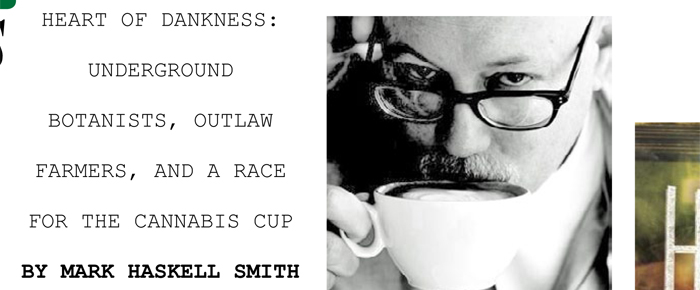
By Heidi Simmons
—–
Heart of Dankness: Underground Botanists, Outlaw Farmers, and the Race for the Cannabis Cup
By Mark Haskell Smith
Non Fiction
—–
Utility, sexuality, medicine, love, poetry, vision and spirit — all good things, all very desirable. These are the seven powers of cannabis. Each is represented by a prong on the cannabis leaf. In Mark Haskell Smith’s non-fiction Heart of Dankness: Underground Botanists, Outlaw Farmers, and the Race for the Cannabis Cup, he shares his quest to understand marijuana and the quality known as “dank.”
Last week, in a one-hour cable special called Weed, CNN’s Dr. Sanjay Gupta apologized for misleading the public about the harmful use of marijuana, and decided to show the world the incredible potential and benefits of this plant. Now, hopefully those who were not sure or afraid will take another look at the qualities contained in marijuana’s bright green leaves and oily buds. Heart of Dankness can help you acclimate on that journey.
Author Smith begins his adventure in Holland, specifically Amsterdam, where smoking pot is legal. The coffeeshops there are not like Starbucks here. There you can choose designer strains of marijuana and smoke it on the premises. It is also the home of the Cannabis Cup, an international tasting competition sponsored by High Times Magazine. It is the most important competition for botanists, growers and seed distributors. Here is where Smith hopes to find his answer to dankness: connoisseur-quality cannabis.
This is a terrific travelogue if you plan to go to Amsterdam or if you want to explore the captivating world of marijuana. In order for Smith to begin his journey, he must have a doctor’s prescription, a medical marijuana card to use the legal medical marijuana dispensaries here in California. Smith is very entertaining. He’s just a regular guy trying to get high — a quality high that is.
His search leads him around Los Angeles dispensaries, Northern California forests, and finally back to Amsterdam where ultimately he does experiences dankness. Along the way, he entertains the reader with chuckle-out-loud humorous observations.
Smith gives us some political history, shares the complicated state and federal laws, introduces us to brilliant growers and amazing advocates and provides glimpses of the huge money it makes as a business all in context to his adventure. For instance, the Netherland coffeeshops paid $400 million in cannabis taxes on gross sales of more than $2 billion!
The one thing missing for me was an understanding of how collectives here in California share the wealth as non-profit organizations. They seem to be doing well. The dispensary Berkeley Patients Group has 1,000 customers a day. It offers its “members” free yoga classes, legal advise, craft classes and more.
In his search for the ultimate dank weed, Smith gets to know popular indica and sativa hybrids — the two basic strains. He tries major varieties and gives descriptions of the flavor and high. Carefully cultivated, they have names like Super Lemon Haze, Jamaican-Me-Crazy, Jillybean, Chocolope, Casey Jones, Tangerine Dream, OG Kush, to name a few. The best, most dank, marijuana Smith smoked was a Cambodian sativa that sells for $9,000 a pound. However, it took Smith more than an hour to come on to an impressive high.
At the start of the book, Smith gives us a list of the cannabis personae, but sadly there is no index, which would be helpful. I suggest you read with a pen or pencil and make note of favorite varieties in the back with page numbers for reference and descriptions.
“He Blinded Me With Science” is a fascinating and fun chapter with a curator who runs a very low profile business in Los Angeles. The dispensary is called Cornerstone Research Collective and you can only get in with an appointment and recommendations from another member. The owner, Michael Backes, says that with the 430 ingredients and 60 different chemicals in marijuana, THC is the least interesting. He says that anything that impairs the user is a side effect. Backes believes the marijuana plant is so smart and adaptable genetically, there are countless and exciting possibilities for pharmaceutical-quality weed.
Backes points out that one of the problems with growing marijuana today is that its cultivation is driven by prohibition. Plants are therefore mostly grown indoors which restricts size — indicas are small and sativas are big — and generates higher levels of THC from artificial light. The best part of the book is when Backes discusses with Smith how plants eat light and convert it into energy making the plant sensitive and amenable to different light frequencies. No, they are not high during this little tête-à-tête. Of course, Smith asks him about dankness and Backes says the best pot is artisanal — in other words, carefully grown like grapes for wine.
During his final trip to Amsterdam, Smith realizes that dankness is not only the quality of the weed but the company you enjoy while smoking it. It is the alignment of everything good and desirable while sharing it with friends.
It’s great to have some insight on how weed is developed and cultivated. Getting to know the varieties and their developers makes the world more familiar and natural. If you are new to the industry, Heart of Dankness is a fun and interesting way to jump in. Like a good travel adventure, we learn as we go along and are entertained in the process. Marijuana is a miracle plant with amazing qualities and huge potential. Thank goodness Gupta came around, now it’s time for us to find our personal dank.











































